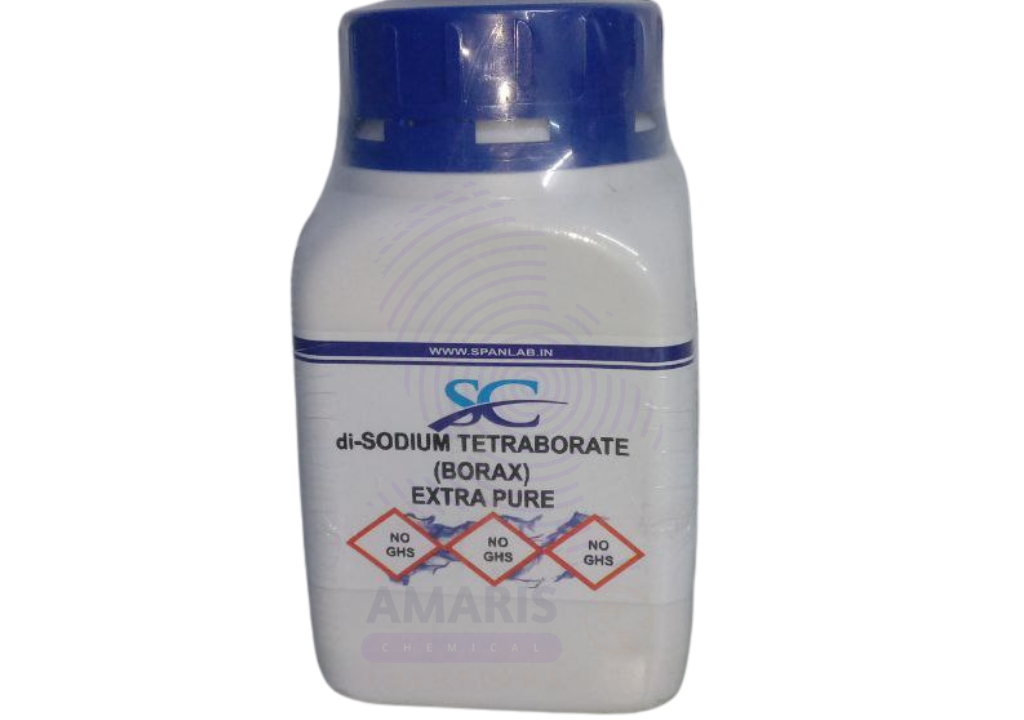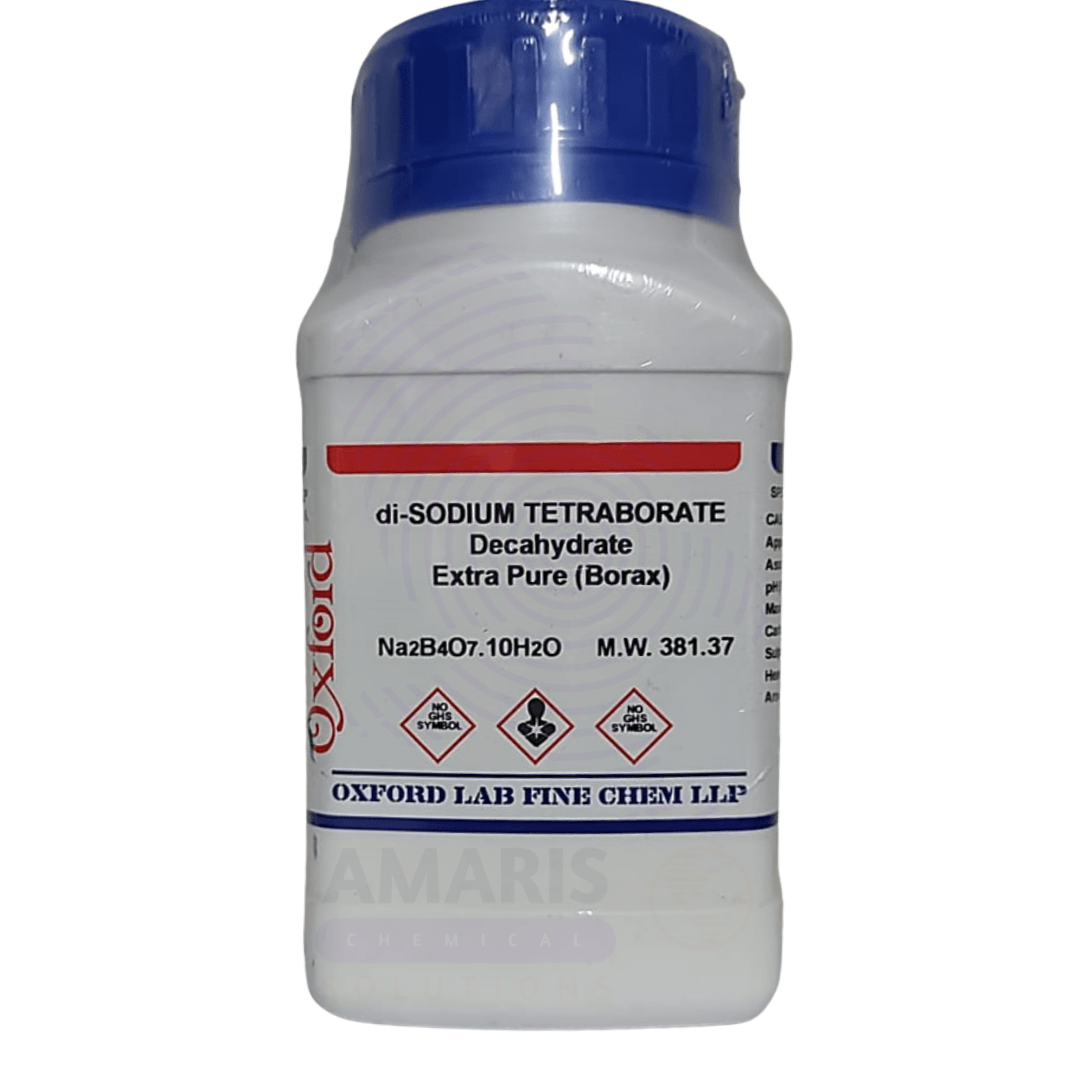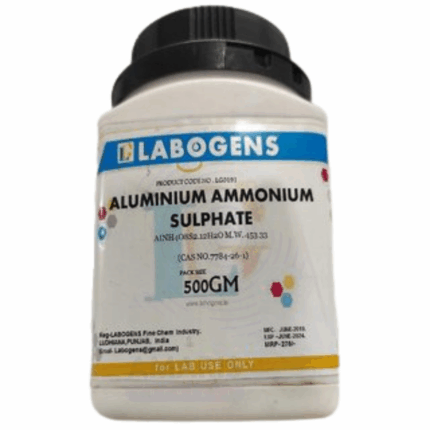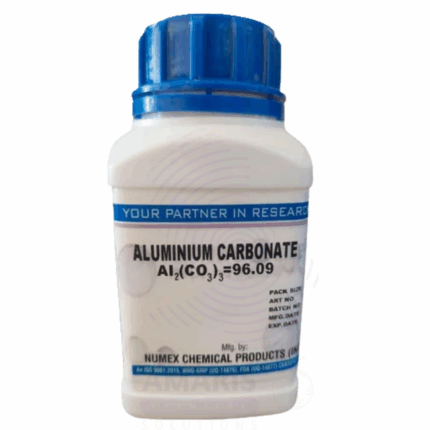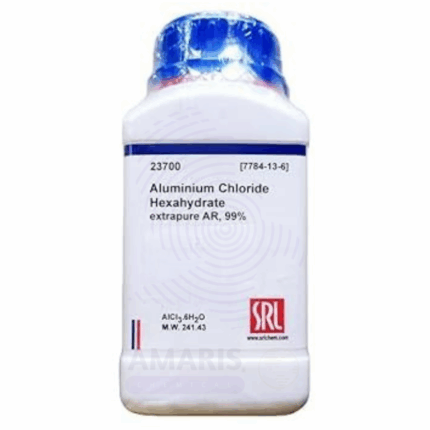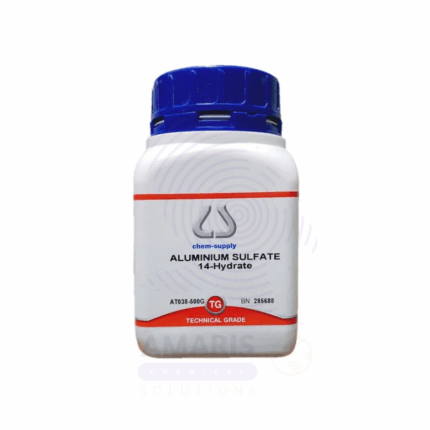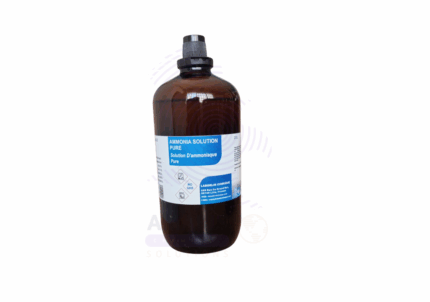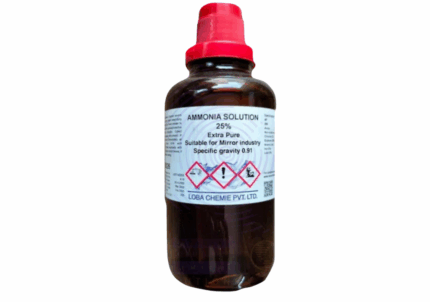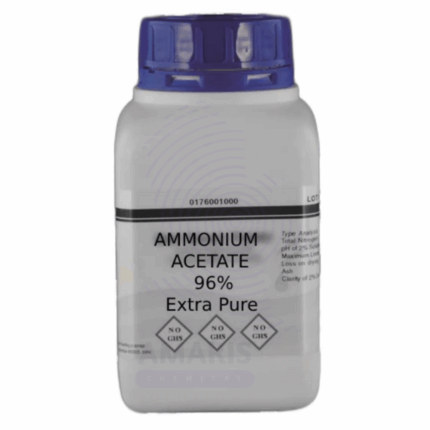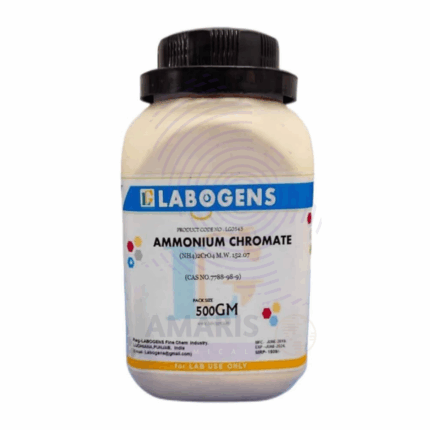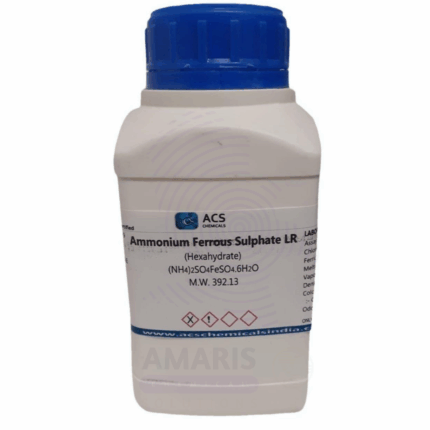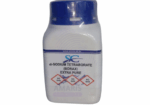
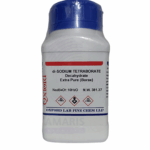


Di-sodium Tetraborate Borax Extra Pure
$ 18.00 Original price was: $ 18.00.$ 17.86Current price is: $ 17.86.
Di-sodium Tetraborate Borax Extra Pure is a high-purity boron compound widely used in laboratory applications for its buffering, emulsifying, and fluxing properties. In analytical chemistry, it serves as a reagent in qualitative and quantitative analysis, particularly in flame tests and as a flux in the preparation of glass beads for spectroscopy. Its buffering capacity is valuable in maintaining pH stability in various solutions, while its detergent-like action supports cleaning and sample preparation. This extra pure grade ensures minimal contaminants, making it ideal for precision work in research, teaching, and industrial laboratories. Store in a cool, dry environment in a well-sealed container.
Di-sodium Tetraborate Borax Extra Pure
Primary Uses
- Buffering Agent
- Used in borate buffer systems for maintaining alkaline pH in biochemical and molecular biology applications.
- Analytical Reagent
- Involved in complexometric titrations and metal ion detection, especially for aluminum and iron.
- Flux in Metallurgy Labs
- Facilitates the melting and cleaning of metals during small-scale metallurgical experiments.
- Staining & Microscopy
- Acts as a mordant or fixative in histological preparations.
Secondary Uses
- Slime/Polymer Labs – Combines with PVA to demonstrate cross-linking chemistry in educational settings.
- Glass & Enamel Studies – As a raw material in synthesis of borosilicate glasses and ceramics.
- Fire Retardancy Testing – Used in testing formulations in fire-resistance experiments.
| PACK SIZE |
500 grams Plastic Tin |
|---|
1. Basic Identification Attributes
- Chemical Name: Di-sodium Tetraborate Decahydrate
- Common Name: Borax
- CAS Number: 1303-96-4
- Chemical Formula: Na₂B₄O₇·10H₂O
- Molar Mass: 381.37 g/mol
- Grade: Extra Pure (Laboratory Grade)
2. Physical & Chemical Properties
- Appearance: White crystalline powder or granules
- Odor: Odorless
- Solubility: Soluble in water; insoluble in alcohol
- pH (1% sol.): ~9.3 (alkaline)
- Melting Point: ~75 °C (loses water of crystallization)
- Boiling Point: Decomposes before boiling
- Density: ~1.73 g/cm³
- Hygroscopicity: Slightly hygroscopic
3. Safety & Hazard Attributes
- GHS Classification: Eye Irritant (Category 2), Reproductive Toxicity (Category 2)
- Hazard Statements:
- H319: Causes serious eye irritation
- H361: Suspected of damaging fertility or the unborn child
- Precautionary Measures:
- Avoid eye and skin contact
- Wear gloves, goggles, and a lab coat
- Do not inhale dust
- First Aid:
- Inhalation: Move to fresh air
- Skin/Eye Contact: Rinse with water
- Ingestion: Rinse mouth, seek medical advice if large amounts are ingested
4. Storage & Handling Attributes
- Storage Conditions:
- Store in a tightly sealed container
- Keep in a cool, dry, well-ventilated area
- Protect from moisture and direct sunlight
- Handling Advice:
- Minimize dust generation
- Use in a fume hood for large-scale experiments
5. Regulatory & Compliance Attributes
- EINECS Number: 215-540-4
- UN Number: Not classified as hazardous for transport
- REACH Status: Registered
- Labeling Requirements: GHS07, GHS08
6. Laboratory Applications
- Primary Uses:
- Buffering agent in biochemical labs
- Precursor in borate buffer solutions
- Emulsifier and flame retardant in formulations
- Used in preparation of slime (polymer crosslinking experiments)
SAFETY PRECAUTIONS
- PPE Required:
- Gloves
- Lab coat
- Safety goggles
- Storage Guidelines:
- Store in a dry, cool, and well-ventilated area
- Keep the container tightly closed to prevent moisture absorption
- Avoid contact with acids, which release boric acid fumes
- Handling Tips:
- Avoid creating dust – use a scoop spatula carefully
- Use only in well-ventilated labs or under a fume hood
- Wash hands after handling
FIRST AID MEASURES
- Inhalation: Move to fresh air; seek medical attention if symptoms persist
- Skin Contact: Wash with soap and water
- Eye Contact: Rinse cautiously with water for at least 15 minutes
- Ingestion (Lab Use): Rinse mouth; seek medical attention—not for food use
FIRE SAFETY MEASURES
- Fire Hazard: Non-combustible
- Explosion Risk: None under normal conditions
- Extinguishing Agents: Use any suitable media (water, foam, CO₂) for surrounding fire
- Thermal Decomposition: May emit sodium oxide and boron oxides at high temperatures


 Preservatives(food)
Preservatives(food) Flavor Enhancers
Flavor Enhancers Acidulants
Acidulants Sweeteners
Sweeteners Antioxidants
Antioxidants Colorants(food)
Colorants(food) Nutraceutical Ingredients (food)
Nutraceutical Ingredients (food) Nutrient Supplements
Nutrient Supplements Emulsifiers
Emulsifiers
 Collectors
Collectors Dust Suppressants
Dust Suppressants Explosives and Blasting Agents
Explosives and Blasting Agents Flocculants and Coagulants
Flocculants and Coagulants Frothers
Frothers Leaching Agents
Leaching Agents pH Modifiers
pH Modifiers Precious Metal Extraction Agents
Precious Metal Extraction Agents
 Antioxidants(plastic)
Antioxidants(plastic) Colorants (Pigments, Dyes)
Colorants (Pigments, Dyes) Fillers and Reinforcements
Fillers and Reinforcements Flame Retardants
Flame Retardants Monomers
Monomers Plasticizers
Plasticizers Polymerization Initiators
Polymerization Initiators Stabilizers (UV, Heat)
Stabilizers (UV, Heat)
 Antifoaming Agents
Antifoaming Agents Chelating Agents
Chelating Agents Coagulants and Flocculants
Coagulants and Flocculants Corrosion Inhibitors
Corrosion Inhibitors Disinfectants and Biocides
Disinfectants and Biocides Oxidizing Agents
Oxidizing Agents pH Adjusters
pH Adjusters Scale Inhibitors( water)
Scale Inhibitors( water)
 Antioxidants(cosmetic)
Antioxidants(cosmetic) Emollients
Emollients Fragrances and Essential Oils
Fragrances and Essential Oils Humectants
Humectants Preservatives
Preservatives Surfactants(cosmetic)
Surfactants(cosmetic) Thickeners
Thickeners UV Filters
UV Filters
 Fertilizers
Fertilizers Soil Conditioners
Soil Conditioners Plant Growth Regulators
Plant Growth Regulators Animal Feed Additives
Animal Feed Additives Biostimulants
Biostimulants Pesticides (Herbicides, Insecticides, Fungicides)
Pesticides (Herbicides, Insecticides, Fungicides)
 Active Pharmaceutical Ingredients (APIs)
Active Pharmaceutical Ingredients (APIs) Excipients
Excipients Solvents(pharmaceutical)
Solvents(pharmaceutical) Antibiotics
Antibiotics Antiseptics and Disinfectants
Antiseptics and Disinfectants Vaccine Adjuvants
Vaccine Adjuvants Nutraceutical Ingredients (pharmaceutical)
Nutraceutical Ingredients (pharmaceutical) Analgesics & Antipyretics
Analgesics & Antipyretics
 Analytical Reagents
Analytical Reagents Solvents(lab)
Solvents(lab) Chromatography Chemicals
Chromatography Chemicals Spectroscopy Reagents
Spectroscopy Reagents microbiology-and-cell-culture-reagents
microbiology-and-cell-culture-reagents Molecular Biology Reagents
Molecular Biology Reagents Biochemical Reagents
Biochemical Reagents Inorganic and Organic Standards
Inorganic and Organic Standards Laboratory Safety Chemicals
Laboratory Safety Chemicals Specialty Laboratory Chemicals(Special Laboratory Equipment)
Specialty Laboratory Chemicals(Special Laboratory Equipment)
 Demulsifiers
Demulsifiers Hydraulic Fracturing Fluids
Hydraulic Fracturing Fluids Scale Inhibitors(oil)
Scale Inhibitors(oil) Surfactants(oil)
Surfactants(oil) Drilling Fluids
Drilling Fluids
 Dyes and Pigments
Dyes and Pigments Bleaching Agents
Bleaching Agents Softening Agents
Softening Agents Finishing Agents
Finishing Agents Antistatic Agents
Antistatic Agents
 Admixtures
Admixtures Waterproofing Agents
Waterproofing Agents Sealants and Adhesives
Sealants and Adhesives Curing Compounds
Curing Compounds Concrete Repair Chemicals
Concrete Repair Chemicals Anti-Corrosion Coatings
Anti-Corrosion Coatings
 Surfactants(cleaning)
Surfactants(cleaning) Builders
Builders Enzymes
Enzymes Solvents (Cleaning)
Solvents (Cleaning) Fragrances
Fragrances
 Electronic Chemicals
Electronic Chemicals Catalysts
Catalysts Lubricants
Lubricants Photographic Chemicals
Photographic Chemicals Refrigerants
Refrigerants Automotive chemicals
Automotive chemicals Pyrotechnic Chemicals
Pyrotechnic Chemicals
 Biodegradable Surfactants
Biodegradable Surfactants Bio-based Solvents
Bio-based Solvents Renewable Polymers
Renewable Polymers Carbon Capture Chemicals
Carbon Capture Chemicals Wastewater Treatment Chemicals
Wastewater Treatment Chemicals
 Pigments
Pigments Solvents(paint)
Solvents(paint) Specialty Coatings
Specialty Coatings Binders/Resins
Binders/Resins Additives
Additives Driers
Driers Anti-Corrosion Agents
Anti-Corrosion Agents Functional Coatings
Functional Coatings Application-Specific Coatings
Application-Specific Coatings
 Fresh Herbs
Fresh Herbs Ground Spices
Ground Spices Whole Spices
Whole Spices Spice Blends
Spice Blends Dried Herbs
Dried Herbs
 Leavening Agents
Leavening Agents Dough Conditioners
Dough Conditioners Flour Treatments
Flour Treatments Fat Replacers
Fat Replacers Decoratives
Decoratives Preservatives(baking)
Preservatives(baking)
 Plasticizers & Softeners
Plasticizers & Softeners Reinforcing Agents
Reinforcing Agents Adhesion Promoters
Adhesion Promoters Vulcanizing Agents
Vulcanizing Agents Antidegradants
Antidegradants Blowing Agents
Blowing Agents Fillers & Extenders
Fillers & Extenders Accelerators & Retarders
Accelerators & Retarders